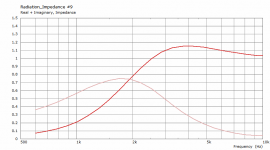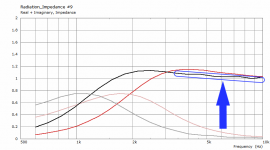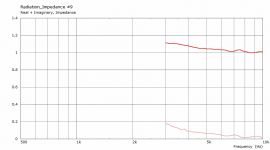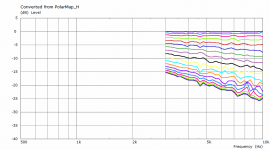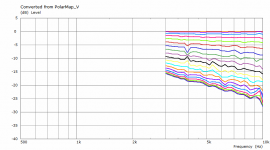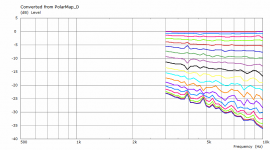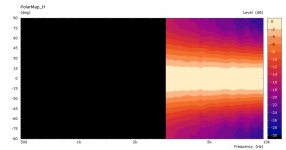No and I don't see a point in trying to qualify it, it's just what it is. In fact "conical" is only a theoretical concept anyway, there's no real conical horn - a truncated conical at best. Not even mentioning the huge variety of shapes possible with the calculator, especially after I implemented the variable profile formula (which is how the recent designs emerged) - not released yet....I wonder whether the ATH4 actually qualifies as a conical horn, as the round-over takes up a significant part of the waveguide.
The reference to conical horns stems from publications, including Kolbrek's "Introduction to Horn Theory". Those references are mainly based on the original OS contour. Yours, of course, is significantly different.
"The value of mouth impedance will dictate the value of the throat impedance." This is interesting, because the ATH is completely different from a truncated (unterminated) conical horn. The mouth section of an arbitrary ATH4 waveguide may, acoustically, show similarities to a Tractrix mouth.
On the other hand, Kolbrek has presented a method to predict at what frequency the throat impedance of the (OS) waveguide becomes too low to be useful.
"The cutoff of the waveguide depends on both the angle and the throat radius. For a low cutoff, a larger throat and/or a smaller angle is required. For example, for a 1″ driver and 60° included angle (θ0 = 30), the cutoff is about 862Hz."
Naturally, for an 1.4" exit (and now I have to use the c-word 😉) the cutoff would be lower and therefore 700Hz seems to be a suitable crossover frequency.
Unless we can get our hands on an exact lumped parameter model of an existing compression driver, the most appropriate way to evaluate the impact of the axial length is to compare (measure) the same driver with different waveguides.
"The value of mouth impedance will dictate the value of the throat impedance." This is interesting, because the ATH is completely different from a truncated (unterminated) conical horn. The mouth section of an arbitrary ATH4 waveguide may, acoustically, show similarities to a Tractrix mouth.
On the other hand, Kolbrek has presented a method to predict at what frequency the throat impedance of the (OS) waveguide becomes too low to be useful.
"The cutoff of the waveguide depends on both the angle and the throat radius. For a low cutoff, a larger throat and/or a smaller angle is required. For example, for a 1″ driver and 60° included angle (θ0 = 30), the cutoff is about 862Hz."
Naturally, for an 1.4" exit (and now I have to use the c-word 😉) the cutoff would be lower and therefore 700Hz seems to be a suitable crossover frequency.
Unless we can get our hands on an exact lumped parameter model of an existing compression driver, the most appropriate way to evaluate the impact of the axial length is to compare (measure) the same driver with different waveguides.
Last edited:
OK, here is the "throat radiation impedance" of the waveguide at hand. Please show me what is the usable frequency limit and why. No need to speculate, we have it calculated. I understand you are saying that there's somethig like a usable limit, I just don't get the "why" part... What consequences will it have using it lower? I just can't imagine you could point a finger at a point in the chart and say "here"... Why?
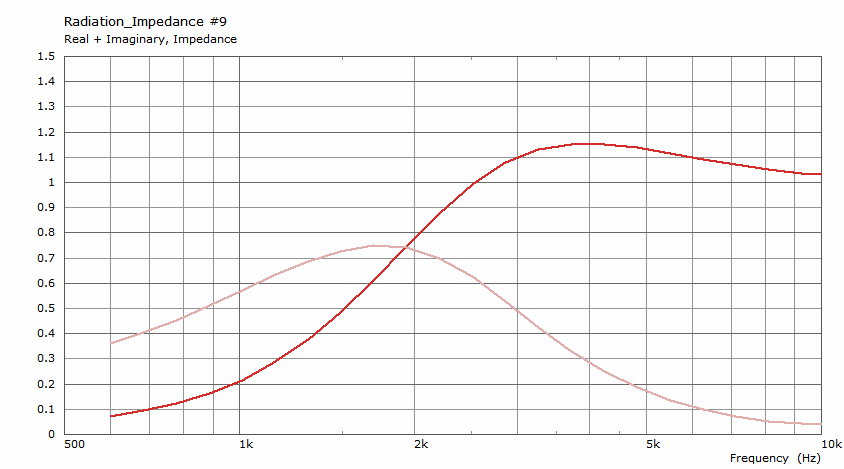
Attachments
Between roughly 680 and 850Hz.
It's an (not entirely) uneducated guess, based on throat impedance plots and associated cutoff frequencies of other horn types.
If you search for the (approximate) lower knee, you'll arrive at those frequencies.
It's an (not entirely) uneducated guess, based on throat impedance plots and associated cutoff frequencies of other horn types.
If you search for the (approximate) lower knee, you'll arrive at those frequencies.
Last edited:
😀 You didn't expect a solid scientific rationale, did you?
Ultimately, you could use a compression driver without horn. I've seen people, mostly Asians, do that.
At home, the mouth size is more important. I've tried the B&C ME60 (20cm depth, undersized mouth) at 600Hz... horrible!
From about the specified 800Hz it get's better.
Ultimately, you could use a compression driver without horn. I've seen people, mostly Asians, do that.
At home, the mouth size is more important. I've tried the B&C ME60 (20cm depth, undersized mouth) at 600Hz... horrible!
From about the specified 800Hz it get's better.
Last edited:
Oh, that would look divine in an automotive pearl paint.A jewel 🙂
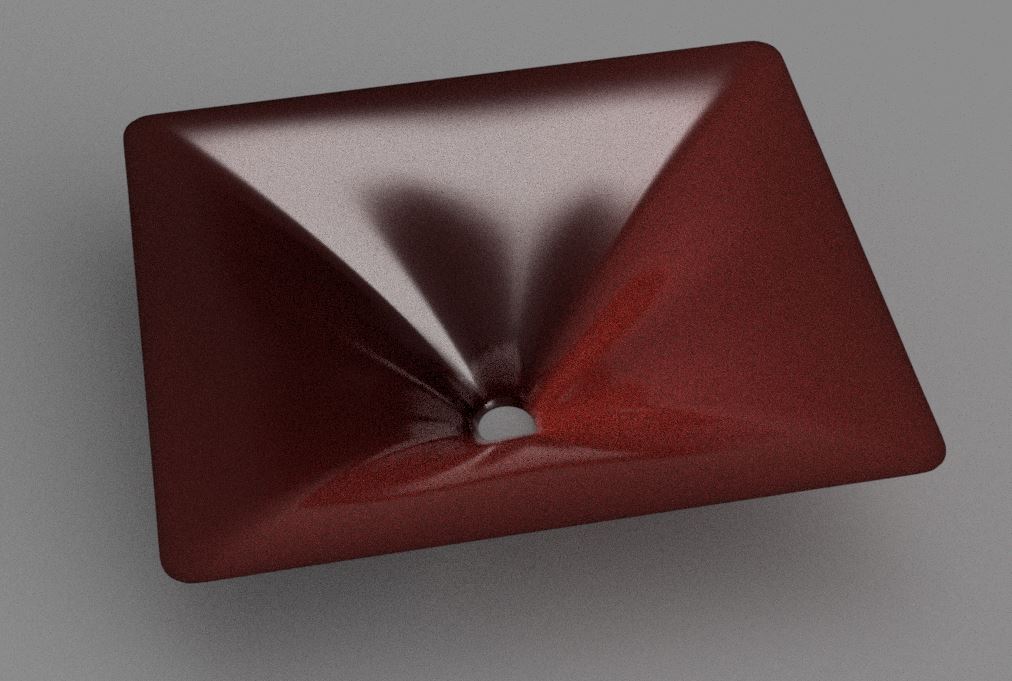
That's hard to tell, I suspect the mesh is still too coarse to judge. I tried once more with just a higher number of frequency points in the incriminated range - there may be some slight resonance(s) around 7 kHz and maybe 9.6 kHz, the rest seems more like a noise to me. A denser mesh would be helpful but it would take too much time at the moment.This is a slight ripple, I suppose?
But it would make sense if a deeper horn was more susceptible to resonances (for about the same mouth size).
Attachments
Last edited:
I understand you are saying that there's somethig like a usable limit, I just don't get the "why" part... What consequences will it have using it lower? I just can't imagine you could point a finger at a point in the chart and say "here"... Why?
Now you see why I object so much to the use of the term "cutoff". It is ill-defined and without much meaning. In physics this term is reserved for modes whose propagation number k goes imaginary. When that happens there literally is zero transmission, but for the lowest mode it never goes imaginary, so by that definition there is no "cutoff".
The impedance (real) is a factor in that it shows efficiency. As it gets lower we have less efficiency of transmission and this would have to be made up for with gain. In many cases, like in my situation, this gain is not an issue as I have sound power to spare. But if that's not the case then a lower impedance will pose a problem with excursion and power dissipation.
But there is no "cutoff".
Last edited:
But it would make sense if a deeper horn was more susceptible to resonances (for about the same mouth size).
Yes, if the circumference of the mouth is identical, the deeper horn is more prone to ripple.
But perhaps Dr. Geddes could fill in a few blanks and rectify any errors.
Last edited:
Yes, if the circumference of the mouth is identical, the deeper horn is more prone to ripple.
To me, that's not quite true. If there is ripple from reflections at the mouth they will tend lower and more dense, but not really more "prone to ripple" - the level of mouth reflection will be the same in both cases. But perhaps it's the english that is a problem here.
"For any horn of finite length a reflection will occur at the mouth and a portion of the original energy will be directed along the horn back towards the driver. Such reflections can lead to the production of standing waves having resonant frequencies related to the horn length. It has been found in practice that there is only a negligible mouth reflection if the mouth perimeter is about 3 times the free space wavelength at the frequency of operation."
But perhaps it's the english that is a problem here.
In my comment, I explicitly refer to the relationship between the size of the mouth (perimeter = circumference) and the axial length (depth) of the horn.
It's plain English. Even Pippi Longstocking would understand.
Whether that statement is correct is up for debate.
Now I wonder what the radiation impedance of the same waveguide with a bigger mouth would look like, but I don't want to burden mabat with yet another time consuming sim.
mabat, ignore the ripple. I haven't been able to find any plausible explanation for this, so let's stick to sim artifacts for now.
One would think that it mainly depends on how well the mouth flare is treated. Should I ask what is the source of the quote? It reminds me the claim that everything longer than 340 mm will sound more like a horn 🙂"For any horn of finite length a reflection will occur at the mouth and a portion of the original energy will be directed along the horn back towards the driver. Such reflections can lead to the production of standing waves having resonant frequencies related to the horn length. It has been found in practice that there is only a negligible mouth reflection if the mouth perimeter is about 3 times the free space wavelength at the frequency of operation."
Last edited:
Thank you, these are the pieces that help to clarify my understanding. So are there any horns at all that do have a cutoff in the proper sense? You said the lowest mode never goes imaginary, which sounds like there is always some transmission in any horn. So is it that in some horns this is just in a form of a more sudden drop?Now you see why I object so much to the use of the term "cutoff". ...
That quote is from Sound System Engineering by Don Davis et al. (4th Edition).
Wrt cutoff, Jack Oclee-Brown prefers 'cut-on frequency'.
"In the far field, when kr≫1, the first term is dominant and the second term tends to zero as the wave-front rate of expansion tends to zero. When kr≪1, the second term is dominant. The transition from the near field to the far field may be characterised by distance at which the hydrodynamic and propagating particle velocity magnitude are equal. For the spherical source this situation occurs at kr=1
At the radiator surface, r=a, this expression indicates the frequency above which the radiation efficiency is maximal and the majority of source volume velocity results in propagated pressure, and the minority, hydrodynamic pressure. In the context of a horn, the frequency corresponding to this condition is called the cut-on frequency, fc.
For the case of a conical horn
fc=c0/2πa
However, with the conical horn the transition from hydrodynamic to propagation is very gentle.
The acoustical horn functions by controlling the wave front expansion in order to reduce the hydrodynamic pressure compared to the propagating pressure, thus allowing more energy to be radiated for a given volume velocity. The behaviour of horns for loudspeakers is very nicely covered by Holland in [30, p.30]."
The same Holland of the claim that everything longer than 340 mm will sound more like a horn 😉
Wrt cutoff, Jack Oclee-Brown prefers 'cut-on frequency'.
"In the far field, when kr≫1, the first term is dominant and the second term tends to zero as the wave-front rate of expansion tends to zero. When kr≪1, the second term is dominant. The transition from the near field to the far field may be characterised by distance at which the hydrodynamic and propagating particle velocity magnitude are equal. For the spherical source this situation occurs at kr=1
At the radiator surface, r=a, this expression indicates the frequency above which the radiation efficiency is maximal and the majority of source volume velocity results in propagated pressure, and the minority, hydrodynamic pressure. In the context of a horn, the frequency corresponding to this condition is called the cut-on frequency, fc.
For the case of a conical horn
fc=c0/2πa
However, with the conical horn the transition from hydrodynamic to propagation is very gentle.
The acoustical horn functions by controlling the wave front expansion in order to reduce the hydrodynamic pressure compared to the propagating pressure, thus allowing more energy to be radiated for a given volume velocity. The behaviour of horns for loudspeakers is very nicely covered by Holland in [30, p.30]."
The same Holland of the claim that everything longer than 340 mm will sound more like a horn 😉
Last edited:
- Home
- Loudspeakers
- Multi-Way
- Acoustic Horn Design – The Easy Way (Ath4)
